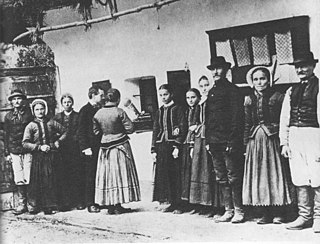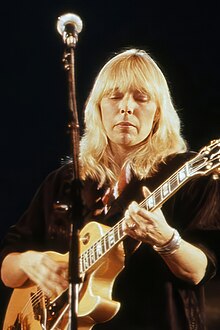
Folk music is a music genre that includes traditional folk music and the contemporary genre that evolved from the former during the 20th-century folk revival. Some types of folk music may be called world music. Traditional folk music has been defined in several ways: as music transmitted orally, music with unknown composers, music that is played on traditional instruments, music about cultural or national identity, music that changes between generations, music associated with a people's folklore, or music performed by custom over a long period of time. It has been contrasted with commercial and classical styles. The term originated in the 19th century, but folk music extends beyond that.

The music of Canada reflects the diverse influences that have shaped the country. Indigenous Peoples, the Irish, British, and the French have all made unique contributions to the musical heritage of Canada. The music has also subsequently been influenced by American culture because of the proximity between the two countries. Since French explorer Samuel de Champlain arrived in 1605 and established the first permanent French settlements at Port Royal and Québec in 1608, the country has produced its own composers, musicians and ensembles.

In traditional Sámi music songs and joiks are important musical expressions of the Sámi people and Sámi languages. The Sámi also use a variety of musical instruments, some unique to the Sámi, some traditional Scandinavian, and some modern introductions.

Buffy Sainte-Marie, is an American singer-songwriter, musician, and social activist.
Indigenous music of Canada encompasses a wide variety of musical genres created by Aboriginal Canadians. Before European settlers came to what is now Canada, the region was occupied by many First Nations, including the West Coast Salish and Haida, the centrally located Iroquois, Blackfoot and Huron, the Dene to the North, and the Innu and Mi'kmaq in the East and the Cree in the North. Each of the indigenous communities had their own unique musical traditions. Chanting – singing is widely popular and most use a variety of musical instruments.
As a cosmopolitan province, Quebec is a home to varied genres of music, ranging from folk to hip hop. Music has played an important role in Quebecer culture. In the 1920s and '30s, singer/songwriter Madam Bolduc performed comedic songs in a folk style with Irish influences. Quebec's most popular artists of the last century include Félix Leclerc (1950s), Gilles Vigneault (1960s–present), Kate and Anna McGarrigle (1970s–present) and Céline Dion (1980s–present).

Tanya Tagaq, also credited as Tagaq, is a Canadian Inuk throat singer, songwriter, novelist, actor, and visual artist from Cambridge Bay (Iqaluktuuttiaq), Nunavut, Canada, on the south coast of Victoria Island.
The Northwest Territories are a territory of Canada.

Murray Edward McLauchlan, is a Canadian singer, songwriter, guitarist, pianist, and harmonica player. He is best known for his Canadian hits "The Farmer's Song," "Whispering Rain," and "Down by the Henry Moore".
"Universal Soldier" is a song written and composed by singer-songwriter Buffy Sainte-Marie. The first released recording was a single by The Highwaymen, released in September 1963. The song was also released on Sainte-Marie's debut album It's My Way!, released in April 1964. "Universal Soldier" was not an immediate popular hit at the time of its release, but it did garner attention within the contemporary folk music community. It became a hit a year later when Donovan covered it, as did Glen Campbell. Sainte-Marie said of the song: "I wrote 'Universal Soldier' in the basement of The Purple Onion coffee house in Toronto in the early sixties. It's about individual responsibility for war and how the old feudal thinking kills us all." The idea was based on that politicians, with power over the military, in democratic states are elected by the people.
Americana is an amalgam of American music formed by the confluence of the shared and varied traditions that make up the musical ethos of the United States of America, with particular emphasis on music historically developed in the American South.

Contemporary folk music refers to a wide variety of genres that emerged in the mid 20th century and afterwards which were associated with traditional folk music. Starting in the mid-20th century, a new form of popular folk music evolved from traditional folk music. This process and period is called the (second) folk revival and reached a zenith in the 1960s. The most common name for this new form of music is also "folk music", but is often called "contemporary folk music" or "folk revival music" to make the distinction. The transition was somewhat centered in the United States and is also called the American folk music revival. Fusion genres such as folk rock and others also evolved within this phenomenon. While contemporary folk music is a genre generally distinct from traditional folk music, it often shares the same English name, performers and venues as traditional folk music; even individual songs may be a blend of the two.

Canadian music genres identifies musical sounds as belonging to a particular category and type of music that can be distinguished from other types of music made by Canadians. The music of Canada has reflected the multi-cultural influences that have shaped the country. First Nations people, the French, the British, the Americans and many others nationalities have all made unique contributions to the musical genres of Canada. During the swing boom of the late 1930s and early 1940s, Canada produced such notable bandleaders as Ellis McLintock, Bert Niosi, Jimmy Davidson, and Mart Kenney. In the 1940s, Bert Niosi and Oscar Peterson became widely known. Canada has also produced a number of respected classical music ensembles, including the Montreal Symphony Orchestra and the Toronto Symphony Orchestra. Canadian rock describes a wide and diverse variety of music produced by Canadians, with the most notable Canadian rock band being Rush, who currently place fifth behind The Beatles, The Rolling Stones, KISS and Aerosmith for the most consecutive gold and platinum albums by a rock band. The Canadian hip hop scene was first established in the 1980s. Some of the most well known Canadian rappers and hip-hop artists include Drake and Maestro Fresh-Wes.
Music of Canadian Cultures is a wide and diverse accumulation of music from many different individual communities all across Canada. With Canada being vast in size, the country throughout its history has had regional music scenes. The music of Canada has reflected the multi-cultural influences that have shaped the country. First Nations people, the French, the British, the United States and many others nationalities have all made unique contributions to the musical heritage of Canada

Country music has a long history in Canada. The genre evolved out of the diverse musical practices of the Appalachian region of the United States. Appalachian folk music was largely Scottish and Irish, with an important influence also being the African American country blues. Parts of Ontario, British Columbia and the Maritime provinces shared a tradition with the Appalachian region, and country music became popular quite quickly in these places. Fiddlers like George Wade and Don Messer helped to popularize the style, beginning in the late 1920s. Wade was not signed until the 1930s, when Victor Records, inspired by the success of Wilf Carter the year before, signed him, Hank Snow and Hank LaRivière.

Willie Thrasher is a Canadian Inuvialuit musician from Aklavik, Northwest Territories. He has recorded both as a solo artist, and as a member of several bands, including The Cordells, and Red Cedar, with Morley Loon. Thrasher has advocated for Inuit and First Nations issues for much of his career.

Power in the Blood is the fifteenth studio album by Buffy Sainte-Marie, released May 12, 2015, on True North Records.
The Purple Onion Coffee House was a music venue at 35 Avenue Road in the Yorkville neighbourhood of Toronto, Canada. It operated from 1960 to 1965. It was a popular venue for folk musicians.

William Prince is a Canadian folk and country singer-songwriter based in Winnipeg, Manitoba.

Medicine Songs is a studio album by Buffy Sainte-Marie, released November 10, 2017, on True North Records. The album includes both new material and contemporary re-recordings of some of her older songs.












